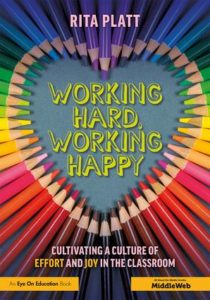Working Hard, Working Happy in the Classroom
Working Hard, Working Happy: Cultivating a Culture of Effort and Joy in the Classroom
By Rita Platt
(Routledge/MiddleWeb, 2019 – Learn more)

Working Hard, Working Happy: Cultivating a Culture of Effort and Joy in the Classroom is a practical guidebook for creating a joyful learning space. Rita Platt relies on her experiences as a teacher, librarian and now principal to reach this conclusion: “The best classrooms are those that have heady doses of both fun and high expectations.”
Platt’s book is an pleasure to read because the chapters are laid out in an easy-to-follow manner.
- A preview of the learning targets for the chapter.
- The big idea or the “whats and whys” of the topic.
- Research highlights, the scholarship, and the evidence base that the chapter is founded on.
- Simple tips, hints, and ideas for implementation.
- Ideas to try.
- A review of the chapter’s main points.

She suggests educators “focus on three things to increase the culture of joy: smiling often, laughing more, and being kind to yourself.” (p. 14) Sounds like the best kind of common sense to me!
Developing a positive climate
Chapter 3, “Where Everyone Knows Your Name,” is perhaps the most powerful chapter in the book. The BIG idea is “a positive school/classroom climate based on relationships is essential for learning.” (p.31) The strategies and tools are solid and can lead to a happy – or happier – classroom environment. The “Fight Your Way Out of a Paper Bag” teaching tip is worth the price of the book!
Since every state, district, and building has their own definition or understanding of educational terms, I appreciated the author’s explanation of how she was defining educational vocabulary in this book. Platt uses this definition of Mastery: “proven ability to perform a skill or strategy with accuracy, or to prove a given learning standard has been met.” (p.57)
For example, when addressing the issue of poor quality in student work, Platt shares five strategies for supporting high-quality work (pp.62-63):
- Assign less but expect more.
- Give students tools.
- Collect work samples to use as anchor papers.
- Develop a quality-work checklist for students.
- Insist on students redoing work that is low quality.
When we expect high-quality work and support students to produce high-quality work, Platt argues that it is easier to move students forward to mastery of standards.
Making differentiated learning work for your students
Anyone who has had negative thoughts and feelings at the mention of Differentiated Learning will be able to turn those around after reading Chapter 5, “Have it Your Way! Differentiated Instruction.” Platt does an excellent job of clearing up much of the confusion about differentiation. Then she provides an abundance of teaching tips and ideas.
Rita Platt is the “real deal”! As a frequent contributor to MiddleWeb, she shares her insights and her wisdom as teacher and administrator. What a delight to see her first book, Working Hard, Working Happy.
Who needs this book? Happy teachers! They will feel validated when they recognize many of their classroom practices. Unhappy teachers! They can cultivate a culture of joy in their classrooms with the practical strategies Rita Platt offers.
Anne Anderson is a retired middle school teacher living in Shreveport, LA. Now she shares her expertise as an educational consultant providing educators with practical solutions to teaching and learning problems. Read all her MiddleWeb articles and reviews here.





































Thank you so much for this kind review, Anne!